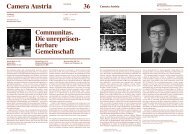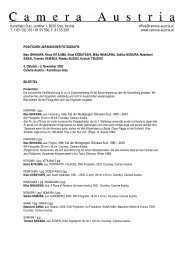Press information (PDF) - Camera Austria
Press information (PDF) - Camera Austria
Press information (PDF) - Camera Austria
Create successful ePaper yourself
Turn your PDF publications into a flip-book with our unique Google optimized e-Paper software.
<strong>Camera</strong> <strong>Austria</strong><br />
<strong>Camera</strong> <strong>Austria</strong> Award for Contemporary<br />
Photography by the City of Graz<br />
Joachim Koester<br />
Contact:<br />
Angelika Maierhofer<br />
T +43/(0)316/815550-16<br />
exhibitions@camera-austria.at<br />
<strong>Press</strong> images:<br />
http://www.camera-austria.at/presse<br />
Jury<br />
Sandra Križić Roban, Publisher Život umjetnosti,<br />
Zagreb<br />
Florian Ebner, Director of the Photographic<br />
Collection at the Museum Folkwang, Essen<br />
Martin Beck, Artist, Vienna / New York<br />
Reinhard Braun, Publisher <strong>Camera</strong> <strong>Austria</strong><br />
International<br />
Award Ceremony: 23 August 2013, 6 pm<br />
The award will be presented by Lisa<br />
Rücker, City Councillor for Cultural<br />
Affairs.<br />
Laudatio: Catherine David<br />
“But in all my works there is a tension between the apparent narrative,<br />
which the viewer immediately sees, and what remains invisible<br />
or illegible”, noted Joachim Koester in a conversation with Anders<br />
Kreuger from the year 2005. His interest lies in the world surrounding<br />
the pictures. As an example, the series “The Secret Garden<br />
of Sleep”, which is comprised of black-and-white photographs of<br />
cannabis plants, a text, and spreads from the magazine High Times,<br />
revolves around a kind of invisible index of things. After Ronald<br />
Reagan was elected president of the United States, he revoked the<br />
liberal drug legislation enacted by his predecessor Jimmy Carter,<br />
thus making it possible for someone to be sentenced to life in jail<br />
for growing cannabis. In the conservative 1980s, cannabis was to<br />
become a symbol of the social upheaval experienced during the<br />
1960s, which Reagan, as governor of California, had already tried<br />
to halt through excessive police operations. Since it became next to<br />
impossible to grow cannabis in open air, amateur botanists started<br />
experimenting with ways of optimising its growth indoors. In other<br />
words, Reagan’s restrictive policies led to a genetic revolution of the<br />
cannabis plant sparked by amateurs and based on the significance of<br />
the plant for America’s countercultural pop culture since the 1960s.<br />
As Joachim Koester mentioned in an interview for the exhibition<br />
“A Blind Spot” curated by Catherine David in 2012, it is this<br />
type of invisible index of “how things are connected in ways that<br />
are not quite apparent”, that fascinates Koester—the actuality that<br />
photography can generate meaning in a specific context only. Rosalind<br />
E. Krauss has said that “a meaninglessness surrounds it<br />
which can only be filled in by the addition of a text”.<br />
Joachim Koester is thus engaged in a field of critical treatment<br />
of the documentary, as it is linked to the history of modernism, for<br />
“The Secret Garden of Sleep” makes reference to the obsession with<br />
modernism by citing real life. While modernist photos of plants<br />
predominately served purposes of description and classification or<br />
were created to assert the intrinsic beauty of nature, the pictures of<br />
cannabis plants taken by Joachim Koester revolve around neither<br />
aesthetics nor classification. Instead, they are dedicated to the (political)<br />
discourse that is inscribed into these plants, as it were.<br />
Joachim Koester already participated in a two-part exhibition project<br />
at <strong>Camera</strong> <strong>Austria</strong> in 2006 and 2009: “First the artist defines<br />
meaning” and “Then the work takes place”. These two exhibitions<br />
explored this relationship between concept and visibility, between<br />
knowledge, history, and image. In the exhibition “Then the work<br />
takes place”, Koester showed the series “The Morning of the Magician”<br />
from the year 2005, which references a commune founded<br />
in 1920 by Aleister Crowley in Cefalù on the island of Sicily. “Closed<br />
in 1923 by order of Mussolini, ‹The Abbey of Thelema› was<br />
abandoned for more than 30 years, only to be rediscovered by the<br />
filmmaker Kenneth Anger who, supported by the sexologist Alfred<br />
Kinsey, exposed the original murals evocative of the tantric practices,<br />
sexual rites, and drug use of the Crowley group.“ (Hal Foster)<br />
Crowley‘s system was a technology of the self, but from the fringes<br />
of official culture. His legacy is that of the “great transgressor“.<br />
—› Joachim Koester, From the Secret Garden of Sleep #6, 2008 / The Abbey of Thelema #4 (aus: Morning of the Magicians), 2005 / Time of the Hashshashin # 1, 2009.<br />
Installation: Institut D‘art Contemporain, Villeurbanne, Frankreich, 2011. Foto: Blaise Adilon. All works: Courtesy: Galleri Nicolai Wallner
<strong>Camera</strong> <strong>Austria</strong><br />
Joachim Koester<br />
<strong>Camera</strong> <strong>Austria</strong> Award for Contemporary Photography by the City of Graz<br />
He transgressed victorian morals in a sort of tour de force of debauchery.<br />
That side of his practice constitutes a direct link to parts<br />
of the later counter culture.<br />
Today, only ruins of the original buildings are left—a metaphor<br />
for the failed utopia. With only bits of masonry, overgrown<br />
pathways, and a view of the town of Cefalù visible, Koester’s documentation<br />
is teeming with gaps, insinuated contexts, and absent<br />
knowledge. In this sense, Joachim Koester brings the photographic<br />
image to the brink of documentation in this series, but then also to a<br />
domain where shifts play out among perception, history, knowledge,<br />
politics, and image. Along the way, the artist intervenes—with unspectacular<br />
yet precise pictures and arrangements of photo series—<br />
in the well-ordered distribution of our sensory experience and their<br />
identification of the visible based on what can be seen. Yet since<br />
Joachim Koester is primarily concerned with what is not seen (or<br />
cannot be seen, or is not allowed to be seen), he unhinges this<br />
Tamayo Contemporary Art Museum, Mexico City; kestnergesellschaft,<br />
Hannover; Institut d’art contemporain,Villeurbanne; MIT,<br />
Boston and S.M.A.K., Stedelijk Museum voor Actuele Kunst,<br />
Ghent.<br />
Joachim Koester participated in two exhibition projects at <strong>Camera</strong><br />
<strong>Austria</strong>: “First the artist defines meaning”, 2006, and “Then the<br />
work takes place”, 2009. His work was published in <strong>Camera</strong> <strong>Austria</strong><br />
International 66/1999.<br />
The <strong>Camera</strong> <strong>Austria</strong> Award for Contemporary Photography by the<br />
City of Graz was established in 1989 and is bestowed every two<br />
years on an artist who has published a noteworthy contribution in<br />
the magazine <strong>Camera</strong> <strong>Austria</strong> International and has made an<br />
important contribution to contemporary photography.<br />
sensory experience and the fabric of the documentary images. As a<br />
result, the reconfiguration of image, knowledge, experience, history,<br />
and meaning becomes essential.<br />
The jury founded their decision to honour Joachim Koester with<br />
this award on the following statement: “The photographic (and also<br />
filmic) work of Joachim Koester convinces thanks to the Danish<br />
artist’s innovative negotiation of relations between the documentary<br />
and the fictional. His series of works associate questions of<br />
knowledge and ignorance, of consciousness and unconsciousness,<br />
with questions related to the body, experience, and the metaphysical.<br />
Extensively researched events from the history of more recent<br />
counter-cultures, long-forgotten occultism, or pre-modern rituals<br />
are transferred into precise photographic series and filmic installations<br />
with high conceptual stringency and visual clarity. In<br />
Koester’s oeuvre, documentary rigour, depth of content, and narrative<br />
ease coalesce with brilliant aesthetic power of persuasion.”<br />
Previous recipients of the <strong>Camera</strong> <strong>Austria</strong> Award include: 2011:<br />
Heidrun Holzfeind (AT); 2009: Sanja Iveković (HR); 2007: Marika<br />
Asatiani (GE); 2005: Walid Raad (LB); 2003:Aglaia Konrad (BE);<br />
2001: Allan Sekula (US); 1999: Hans Peter Feldmann (DE), 1995:<br />
David Goldblatt (ZA); 1993: Seiichi Furuya (JP/AT); 1991: Olivier<br />
Richon (CH/GB); 1989: Nan Goldin (US).<br />
Joachim Koester is an artist born in 1962 in Copenhagen, Demar<br />
His work has been shown at documenta X, Kassel; Johannesburg<br />
Biennial; Venice Biennial; Manifesta, Trento; Tate Triennial,<br />
London.<br />
Recent solo shows include CASM, Center d’Art Santa Monica,<br />
Barcelona; Palais de Tokyo, Paris; Moderna Museet, Stockholm;<br />
—› Joachim Koester, Time of the Hashshashin # 4, 2009 / Time of the Hashshashin # 6, 2009 / Message from Andrée, 2005. Installation: The Venice Biennale 2005 / All<br />
works: Courtesy: Galleri Nicolai Wallner.




